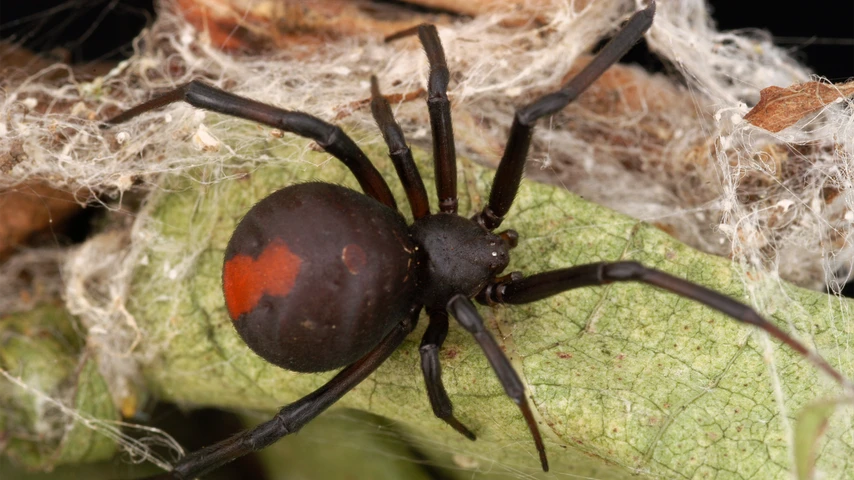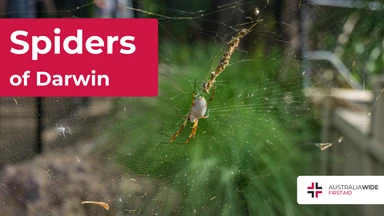Redback Spider Bite


Redback spiders are considered native to Australia and are found across the country. They prefer to build their webs in dry, sheltered sites, and so they are common in close proximity to human habitation.
Bites from a female Redback have been known to cause serious illness and even death.
Female Redback spiders are typically black in colour, though they can sometimes be brown. Their most distinctive feature is a red or orange stripe on the top of their abdomen.
Male Redback spiders, meanwhile, are usually light brown in colour with white or yellow markings on their abdomen, as opposed to red or orange ones.
Both male and female Redback spiders have an hourglass shaped marking on the underside of their abdomen. This marking tends to be paler in males, compared to females. Male Redback spiders are also much smaller than their female counterparts - they only grow to 5mm, which is modest compared to the female's general size of 1 cm.
Redback Spiders can be found across Australia wherever there is sufficient food, shelter, and warmth.
Due to their predilection for dry, sheltered sites, Redback spiders tend to build their nests close to human habitation in sheds, toilets, and under rocks and junk piles.
Their nests typically comprise a funnel-like upper retreat area surrounded by sticky catching threads.
Redback spiders are generally retiring creatures and only bite in defence. And though females have been known to steal prey from other webs, they usually stick to their own webs.
To this end, female Redback spiders tend to be more aggressive than their male counterparts. They are also the only ones capable of harming humans - the fangs of male Redback spiders are too small to penetrate human skin. As such, it is unlikely for a human to be bitten by a Redback spider unless one of their body parts, such as a hand, comes into direct contact with a web or a female.
The venom from a Redback spider acts directly on the nerves and results in the release and subsequent depletion of neurotransmitters. More than 250 victims of Redback spider bites receive antivenom each year. It is thought that an additional number of envenomations go unreported each year due to the mildness of the symptoms. Redback spider bites can cause serious illness and have resulted in deaths, though no deaths have been reported in Australia since 1955, a year before antivenom was introduced.

Redback spider bites are characterised by intense localised pain, redness, and swelling around the bite site. Other common symptoms of a Redback spider bite include:
The bite site is likely to remain red and itchy for a few days after the bite occurs. If symptoms are still present after 7 days, visit your doctor.
For more information about how to provide first aid for a Redback spider bite, watch the video below:
Some people can have a severe allergic reaction when bitten by a spider. This is called anaphylaxis, a condition that can be fatal in as little as 15 minutes. Symptoms include:
If the casualty begins exhibiting any of the above symptoms, call Triple Zero (000) for an ambulance, consult the Australian Resuscitation Council's anaphylaxis treatment guideline, and follow DRSABCD and prepare to perform CPR.
If you would like to learn more about providing first aid in the event of a bite or sting, book a First Aid course with us today.
We also have articles on what to do if you get stung or bitten by snakes, fire ants, and marine life.
And for more details on how to identify and treat bites from some of Australia's deadliest spiders, including White tail spiders, Wolf spiders, and Huntsman spiders, head to our Resource Library.
Disclaimer: This article is for informational purposes only. It does not constitute, replace, or qualify as any form of first aid training.
We run certified First Aid courses throughout all major Australia citys. Find a location near you.

March 11, 2025
Darwin, the tropical capital of Australia’s Northern Territory, is home to a rich diversity of wildlife - including an impressive array of spiders. From the sprawling webs of golden orb-weavers to the cryptic camouflage of trapdoor spiders, these arachnids play a vital role in the local ecosystem. While some may inspire fear, the majority are harmless and even beneficial, helping to control insect populations.

September 4, 2024
Cat bites, while often underestimated, can lead to serious health complications if not treated promptly and properly. Cats' mouths harbour a variety of bacteria that can cause infections in humans.

April 1, 2024
Encounters with wildlife can often be thrilling, but when it comes to the creature known as the drop bear, the experience can quickly turn dangerous. A sharp increase in recent attacks prompts the need for understanding proper first aid procedures in case of an attack.